The Northern Marianas Islands
A strategically Located Tropical Paradise Full with Untapped Potential

Being at the crossroads of Asiaand America, the Commonwealthof the Northern Mariana Islands, CNMI, has been on the front line of geopolitics for over a century, and looking into the future, it certainly has plenty of potential as one of the most strategic locations in the United States of America. In its long, disputed history, the 14-island archipelago has gone from being colonized by Spain, sold to Germany, ruled by Japan for over three decades and then liberated by the USA during World War II, when its Tinian military airport was one of the busiest in the world. Later, in 1978, it became a commonwealth U.S. territory, with its residents being granted U.S. citizenship almost a decade later. Today, like in the past, the CNMI stands at yet another pivotal moment as it redirects its economic and military potential towards new horizons. Following the economic crisis brought by the loss of its garment industry, which ran from the 1980’s until the early 2000s, hence leaving mass unemployment and migration, their situation was later aggravated by the Covid-19 pandemic, visa restrictions (particularly to Chinese citizens, who had visa-free access and made up their second largest tourism market) and the devastation brought by Typhoon Mawar in 2023.
However, and indicative of their longstanding historical resilience, they have managed to surpass those crisis and now look forward to new opportunities that will guarantee a safer and more sustainable future. For instance, last year the U.S. military announced it will spend some $5 billion in military and civilian infrastructure development on the island of Tinian, which is expected to become U.S’. next strategic base in the Pacific, and which will bring a vital economic boost to the island, particularly after the closure of its Chinese-owned casino following U.S. restrictions. And while key improvement works at the Tinian harbor have already begun, there are talks of future repairs to increase the capability of the dual-use port, which is the key supply gateway for Tinian residents and supports the region’s military operations. Other crucial developments include two new subsea cables, Proa and Taihei, which are part of Google’s $1 billion investment to expand the Pacific Connect initiative and will connect Guam, CNMI and Japan. Furthermore, by creating new fiber-optic routes between the continental U.S. and Japan, these cables will improve the reliability and resilience of digital connectivity between the two countries and within the Pacific Island countries and territories, a key condition for boosting existing businesses and establishing new ones around technology and innovation, like additive manufacturing.
On the other hand, the CNMI has great potential for developing further its main economic driver, the tourism industry, thanks to its unique blend of pristine beaches, spectacular caves and tropical lands perfect for all types of leisure activities and sports; well-preserved indigenous traditions dating back to 4000 years, like their open-sea celestial navigation in “proas”; and history-rich sites from their diverse colonization periods, from prehistoric stone structures or “latte” stones to World War II shipwrecks and airfields —one of which is the site from where the atomic bomb carrier Enola Gay was launched—, all existing in a friendly and safe environment ruled by U.S. laws. Although the tourism industry was hit hard by the pandemic, in the last couple of years it has started to recover, with visitors doubling in January 2024 compared to the same period last year. However, since numbers are still low in relation to pre-pandemic indicators, with a total of 215,543 tourists visiting the CNMI in 2023 compared to 487,008 in 2019, the government is trying to build more ties with longstanding partners like Korea and Japan, their first tourist markets, and more recent ones like India. As CNMI governor Arnold Palacios recently said, “We need sustainable partners like Korea, Japan, Taiwan, and India. We need to put together a policy of 40-50 year stable investment and relationships with friends of the United States.” Simultaneously, at the local level, institutions like the Hotel Association of the Northern Mariana Islands and the Saipan Chamber of Commerce launched a plan for economic survival known as “Operation 500k”, that seeks to attract 500,000 tourists annually by recovering old markets such as the Chinese, which made up around 40% of the visitors before the pandemic and would likely come back if current visa restrictions are lifted, or promoting new ones like Taiwan and other Asian destinations.
Furthermore, the Commonwealth of the Northern Mariana Islands is actively engaged on educating its young population and attracting more U.S. workers into jobs held by foreigners, in order to face one of its most important challenges (which is also shared by all Pacific island states and territories): the lack of skilled labor and mass migration. Currently, there is a high demand for healthcare personnel and skilled construction workers; that is why, since fiscal year 2021, the CNMI government has spent between $1.8 and $2.4 million annually on vocational education, apprenticeship, and other training programs for U.S. workers, focusing on fields such as nursing, construction, business, hospitality, and tourism.
Being in a part of the world whose strategic location and remoteness has set its own particular challenges as well as opportunities, we are sure the people of the CNMI will continue doing what has defined them for thousands of years: showing incredible resilience to adapt and thrive.


